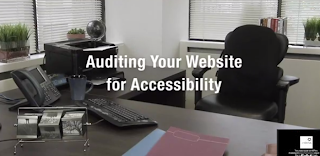 |
| Photos should have Alternate Text: i.e., caterpillar on leaf |
I make numerous complaints to the newspapers to which I subscribe. Most I do not access on paper, most I pay for a subscription online, and most have crazy webpages with flashing images. There are too many with pop-up ads, which drive us all nuts.
These pages are totally user and disabled-unfriendly. As our financial advisor says: there is much mice-type on many pages. Also, many pages with images that are simply too large and take up too much time to upload.
Those with text-to-speech computers need to have information on graphics, alternate text that explains the image.
| The complete regulation can be found on the Ontario Government site. |
This is true, too, for those with visual impairments. The mice-type should be convertible to a larger font, right on the header.
I have found many websites, created by amateurs, who fail to meet basic standards of webpage design. This means that potential customers will leave the site, rather than facing the frustration of navigating it, trying to find that crucial piece of information that eludes them.
[ Does Your Website Provide Easy Access To Your Best Content? video]
 |
| Principles of webpage design |
I've done a lot of work in this field, back when I started teaching webpage design for my students. They loved the bells and whistles: huge graphics, music, animated gifs, too many colours and fonts, but these are not user-friendly for adults. Most of us want to get to the message right away, and find out the information we want immediately, perhaps printing it for later reference.
 |
| User options |

I created a Mind Map, which illustrated the Principles of Design, for my workshops.
You want the right font for your readers (professional and crisp or casual). You want the right font for titles (sans serif), while using serif fonts for text to encourage the reader to move to the next word, and so that the TITLE will stand out. You want to repeat the font, having consistency, limit the number of colours, and have a standard header for each subpage.
 |
| Here is a good video to help Also this one |
A free PDF Guide on compliance with the Integrated Accessibility StandardsRegulation: the impact on your organization, how to comply and by when.
Websites and Web Content
- All Large and Public Sector organizations are required to make their Internet and intranet websites and web content conform to the World Wide Web Consortium Web Content Accessibility Guidelines (WCAG) 2.0.
- Government of Ontario and Legislative Assembly must conform to WCAG 2.0 Level AA while public sector and large organizations are able to first conform to Level A and increase to Level AA in accordance to the schedule set out in the Regulation.
 |
What I found amusing is that this website: Accessible Website Audit and Design - PeopleAccess, violates a number of basic principles.
It has a header that displays two separate headers, both very large and fairly meaningless, with one photo that looks like the generic iStock photos that are far too ubiquitous.


4 comments:
thanks for the tips!
I think a most folks have their own agenda when it comes to web design and what they feel will "sell" their site. Artist/photographers are going to go heavy on the graphics and photos, and writers will be more inclined to promote the text. A good designer will find the right balance but that's just not all that easy for the average person.
I try my best to just make my site pleasant to the eye and easily readable.
When I first started I had a red background. I got tons of complAints because it was hard to read!
Post a Comment